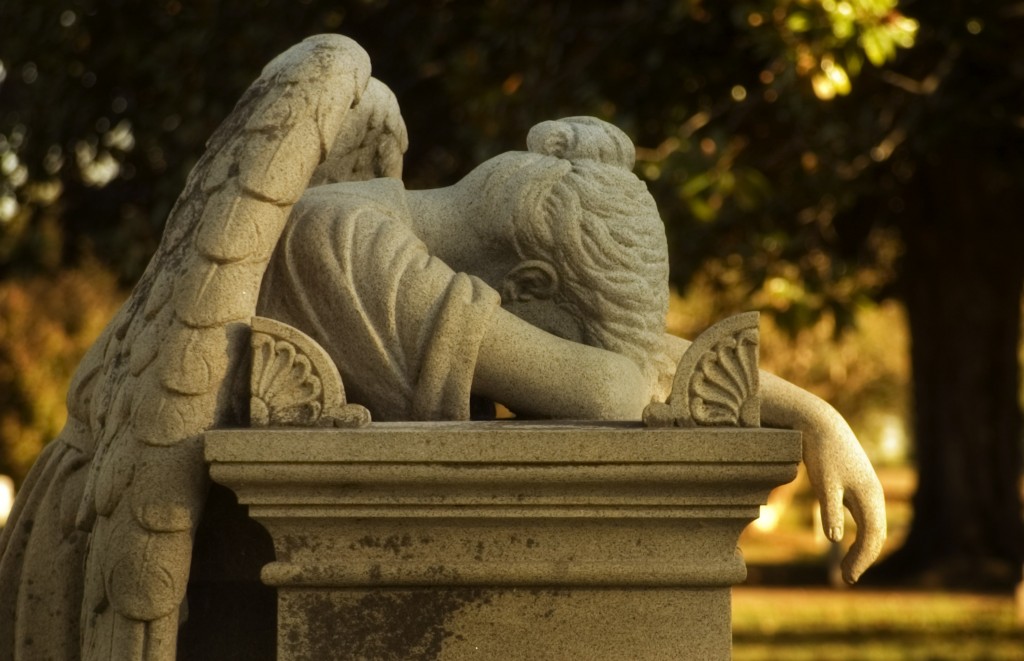by Cara Modisett
When my sister and I were children, on Sundays after church, while the grownups talked about things grownups talk about, she and I would leave the sanctuary with its wooden pews and stained glass windows, head through the vestibule where everyone hung their coats and hats and out of the little church’s double doors. There was no playground; there were few children – much of the time, just us – and so we would play in the cemetery.
Part of the cemetery is very old, soldiers and young women and old men and babies buried under the cedar trees, some with headstones so worn you can barely read them. From that green expanse of grass and granite scattered through with silk flower arrangements, you can see the blue ridgelines of the mountains in the distance. Our great-grandparents are buried there, and cousins and uncles and aunts on both sides of the family. Since childhood, those gravestones have included more and more loved ones, family members we visited on Sunday afternoons in the living rooms and kitchens of their farmhouses. My great uncle and great aunt – he, a farmer and she, his wife, and two of their three sons, one of whom died before he was five years old, the other when he was more than 70. My grandmother is there – my mother’s mother, who lived just up the road from us and hemmed our dresses and made us meatloaf and rice pudding. My namesake is there, Martha Ellen, a woman I never met, and her husband Staige Hite, whose first name is my nephew’s middle name. And that cemetery in the Shenandoah Valley is where we’ll be one day, my parents, my sister and me.
I grew up familiar with the sacred ground of cemeteries, and also the sacred ground of Civil War battlefields. For years, we arrived at that church after driving over the mountain at New Market Gap. We learned in elementary school social studies classes that our valley was called the Breadbasket of the Confederacy, and for my family it was literal in one sense. My great-great-grandfather wrote down my great-great-great-grandmother’s memories of feeding General Ashby’s retreating troops when they came through the farm, “grabbing freshly baked bread from Grand-mother’s kitchen table” – she said, and he wrote. “They snatched the baby’s diapers hanging on the line, to wrap it in, which amused the children immensely.”
That war – General Ashby’s war, my great-great-great-grandmother’s war – seems very far away in time, difficult to comprehend, and yet also very near.
I was reading a story in The Atlantic about Columbus, a town in Mississippi which became a hospital town for troops in the Civil War. The soldiers who died – mostly Confederate, more than 2,500 of them, but also a few Union – were buried in the town’s Friendship Cemetery, and the story goes that in April 1866, that cemetery in Columbus was the place, or at least one of the places, where Memorial Day was first marked.
Four women from the town decorated the graves of their southern dead, and, most likely being mothers and widows and daughters and sisters, they also decorated the graves of the northern dead too, knowing those young men were mourned by their own mothers and widows and daughters and sisters.
No other war drives home for us the self-destruction that war can be. The Civil War, as we know and hear and repeat over and over in social studies classes and Ken Burns documentaries, was not just American against American, but brother against brother, father against son, friend against friend. Enemy was not a faceless, unknown other.
In the beginning of chapter seven of Luke’s Gospel, Jesus puts into action words he has just spoken days or perhaps hours before. In the sixth chapter of Luke, he teaches: love not just your neighbor, but also your enemy. In the seventh chapter, he lives out his words, answering the plea and the faith of a Roman soldier, a soldier he doesn’t even come face to face with because the soldier does not feel worthy, a soldier just like the soldiers who will eventually mock, torment and kill him.
Jesus’ enemy reaches out to him, and he listens; he reaches back, in compassion, in love. Jesus looks past the difference of the other to instead see what they have in common, to see the human behind the uniform, the heart behind the authority, the hope behind the words.
It is easy to view others through the lens of opposite politics, power or theology – to discount, stereotype, villainize, condemn. It is more difficult to see them as part of us, afraid, trusting, humble, faithful, family, loved.
Cara Modisett serves as Minister of Communication for Church of the Holy Communion in Memphis, Tennessee. Prior to that, she was communications advisor to the Episcopal Diocese of Southwestern Virginia and music director at St. Elizabeth’s Episcopal in Roanoke, Virginia.
image: Teasdale Angel, Friendship Cemetery, Columbus, GA

